Ancestry.com: Crowdsourcing Genealogy

Ancestry.com uses a combination of technology, historical archives, DNA testing and the contributions of members to help amateur genealogists trace their family histories. Ancestry has over 2.5M paying subscribers and over 20Bn records dating back to the 13th century that have been added over the past 20 years with ~2M new records added per day.[1] Ancestry brings the power of the crowd to genealogy and thus increases direct network effects and reduces multihoming on its platform.
Creating value and the power of the crowd
Subscribers to the platform begin by creating a family tree and inputting the known members. They can actively search for the historical records of these people in Ancestry’s digital historical archive and add attachments to the tree such as immigration forms as well as upload their own documents. Ancestry’s software then works behind the scenes to scan and match the new user family tree with other trees and information in the network – since 2008 they have made over 10Bn connections between trees. If Ancestry finds a potential match they notify the member with a “hint”. The hint may include other documents in the database or a match to another tree enabling the members to trace their genealogy even further. Member trees and uploads significantly increase the value of the platform, and to date members have created 80M family trees with over 10Bn ancestral profiles and have uploaded more than 175M photographs, scanned documents, and written stories.[2]
In 2012, Ancestry launched a consumer genomics product called AncestryDNA. Customers send in a sample of their DNA and Ancestry returns information about their ethnic mix and compares it to other DNA samples in its database to find potential ancestral matches. AncestryDNA improves the genealogical discovery process by giving users another dimension on which to search. So far Ancestry has 3M active DNA customers and as more members participate the platform will become more powerful and stickier.[3]
Participation incentives
Ancestry’s push notification about hints help to keep users engaged for even if they take a break from actively searching for ancestors, the technology is always working.
Members have the ability to adjust their privacy settings on their trees, however the default setting is public. If your tree is public other users can view all the content you’ve posted except for information about living people and you will get credit for anything you post. There is a tradeoff between privacy and the efficacy of the platform as a whole, however for the amateur genealogists who are serious about discovering their family history the benefits of having a public profile outweigh the costs since they can actively participate in the community.
Capturing value
Ancestry has a fairly simple value capture model that combines both a subscription and transactional component. The subscription membership gives users access to Ancestry’s database, matching technology, and public user profiles for a monthly fee of $19.99 to $44.99, and they can also hire a professional genealogist through the site for an additional fee. Ancestry sells the AncestryDNA as a standalone product for $99. According to CEO Tim Sullivan “as the DNA business has exploded, it has re-accelerated the growth in the core business, bringing costs of new subscriber acquisition down”, and the company says that about 15% of DNA kit buyers become Ancestry subscribers.[4] The company is considering a 2017 IPO and has reported that 2016 revenues were $850M, up 25% year-over-year with ~$300M in EBITDA.[5]
Growth opportunities and challenges
According to a 2013 report by Global Industry Analysts, there are more than 80M professional and amateur genealogists globally, and it projects that the market for genealogy products and services will reach $4.3Bn by 2018.[6] If this prediction is even close to the truth then Ancestry has room to grow with 2.5M members and $850M in revenues.
The main challenges facing Ancestry are competition from competitors and the availability of records. Ancestry can stay ahead of the game by focusing on ways to make its platform stickier via improved technology, driving more people to the platform via AncestryDNA, and the acquisition of more databases. However, the power of the crowd is what will really set Ancestry apart as it gains critical mass. Individual members, via document uploads and DNA testing, are able to fill in information gaps where historical records have been destroyed by war or revolution as in World War II, the Cultural Revolution, and the Partition of India, or where they don’t exist as in the case of written records for African American users prior to the Civil War. [7]
[1] http://www.ancestry.com/corporate/about-ancestry/company-facts
[2] http://www.ancestry.com/corporate/about-ancestry/company-facts
[3] http://www.ancestry.com/corporate/about-ancestry/company-facts
[4] https://www.forbes.com/sites/miguelhelft/2017/01/10/ancestry-com-dna-database-tops-3m-sales-rise-to-850m-ahead-of-likely-2017-ipo/#32f658f613b3
[5] https://www.forbes.com/sites/miguelhelft/2017/01/10/ancestry-com-dna-database-tops-3m-sales-rise-to-850m-ahead-of-likely-2017-ipo/#32f658f613b3
[6] http://genealogysstar.blogspot.com/2013/09/is-genealogy-now-in-mainstream.html
[7] https://www.fastcompany.com/3048513/ancestors-inc-inside-the-remarkable-rise-of-the-genealogy-industry





Thanks for your post! How should ancestry.com think about creating stickiness around their platform with competitors like 23andMe that are also focused on ancestry as well as other type of genetic services? Does it make sense to focus on the core ancestry product or branch out into other services such as integration of other activity, DNA, genomics data?